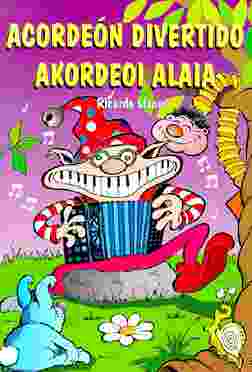
About the History of the Accordion
About the Functioning of the Accordion
About the Upholding of the Accordion
Fiuu, the Bellows
La-Do Position
Mi-Sol Position
Si-Re-Fa Position
Travel to China: Mi-Sol-La-Do Position
Fa-Sol-La Position
Do-Re-Mi Position
Moves of Fingers
Um-Pa-Pa
The Worm: The Chromatic Scale
Thirds and Sixths
Various Techniques
Appendix 1: Songs for Monsters
Appendix 2: A Bit of Parallel Technique
Appendix 3: Chords
Appendix 4: Scales
Appendix 5: Lyrics
Methodologic Guide
total pages: approximately 200
Illustrations: approximately 100
Published: 1998
review date: May 1999
Publisher: Erviti Musica
Order from:
Ricardo Llanos
Juan XXIII 5-6ºizq
E-01004 Vitoria-Gasteiz
Spain
email: r.llanos@euskalnet.net
Review by Henry Doktorski:
Acordeón Divertido / Akordeoi Alaia / Jolly Accordion is a wonderful book: a step-by-step method for Spanish and Basque students of the chromatic button free-bass accordion. Besides its commendable content, the book is also beautiful; its high-quality pages and binding will last a long time. Ricardo Llanos has targeted the book toward children, but adults will also appreciate the chapters on the history and construction of the accordion, as well as the music.I was impressed with the first two chapters. How many accordion method books include sections about accordion history and construction? I learned a few things from reading chapter one: the great musician and scholar Michael Pretorius wrote a treatise in 1619 which described the free-reed. Llanos also mentions the contributions of other important accordion historical personalities, such as Giovanni Gagliardi, Narcisse Decornoy, Pietro Frosini, Hugo Herrmann, Alain Abbott, Mogens Ellegaard, V. Mancini, Joseph Macerollo, Friedrich Lips and Matti Rantanen.
Llanos is to be commended for his chapter on the bellows; truly the heart of the instrument. Before the student learns the button-board, he or she learns to play the bellows; quarter notes, half notes and eighth notes on single pitches. The student learns to sustain long tied notes with crescendos and decrescendos of various dynamic levels, from pp to ff, including accented notes and subito piano.
Finally in chapter five the student begins learning the different notes for both hands, as the left hand plays everything in unison with the right for the first few lessons. The note vocabulary increases with each chapter until the student begins to play nursery rhymes and popular folk tunes. In chapter twelve the student begins to play simple melodies by Offenbach, Beethoven and Paganini.
One of my favorite sections of the books is Appendix 1: Songs for Monsters. Llanos cleverly introduces the young student to some twentieth-century accordion techniques such as tone clusters, air-button hisses, scratching the bellows, tapping on the instrument and tremolo. The drawings of the monsters are hilarious!
I recommend Acordeón Divertido / Akordeoi Alaia / Jolly Accordion for all beginning students of the chromatic free-bass accordion. Even if the student does not read Spanish or Euskara (the two languages of Spain) or English, they will enjoy the logical progression of the lessons. (All the text has been translated into English in the second edition.)
| About The Free-Reed Review |
| Invitation to Contributors / Submission Guidelines |
| Back to The Free-Reed Review Contents
Page |
| Back
to The Classical Free-Reed, Inc. Home Page |